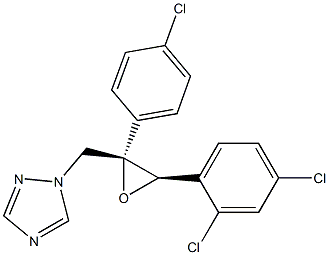TRANS-STILBENE OXIDE
Synonym(s):trans-1,2-Diphenyloxirane
- CAS NO.:1439-07-2
- Empirical Formula: C14H12O
- Molecular Weight: 196.24
- MDL number: MFCD00064311
- EINECS: 215-877-7
- SAFETY DATA SHEET (SDS)
- Update Date: 2024-12-18 14:07:02

What is TRANS-STILBENE OXIDE?
Chemical properties
white to light yellow crystal powde
The Uses of TRANS-STILBENE OXIDE
trans-Stilbene Oxide is used in preparation method of metal complex covalent organic framework material.
What are the applications of Application
trans-Stilbene oxide is an expoxide for biological research
Definition
ChEBI: R-trans-stilbene oxide is a trans-stilbene oxide. It is an enantiomer of a S-trans-stilbene oxide.
Properties of TRANS-STILBENE OXIDE
| Melting point: | 65-67 °C(lit.) |
| Boiling point: | 273.14°C (rough estimate) |
| Density | 1.0405 (rough estimate) |
| refractive index | 1.4700 (estimate) |
| storage temp. | 2-8°C |
| solubility | soluble in Toluene |
| form | Crystals |
| color | White |
| BRN | 82740 |
| CAS DataBase Reference | 1439-07-2(CAS DataBase Reference) |
| EPA Substance Registry System | Oxirane, 2,3-diphenyl-, (2R,3R)-rel- (1439-07-2) |
Safety information for TRANS-STILBENE OXIDE
| Signal word | Warning |
| Pictogram(s) |
 Exclamation Mark Irritant GHS07 |
| GHS Hazard Statements |
H315:Skin corrosion/irritation H319:Serious eye damage/eye irritation H335:Specific target organ toxicity, single exposure;Respiratory tract irritation |
| Precautionary Statement Codes |
P280:Wear protective gloves/protective clothing/eye protection/face protection. |
Computed Descriptors for TRANS-STILBENE OXIDE
TRANS-STILBENE OXIDE manufacturer
Dr. Silviu Pharmachem Pvt., Ltd.
1Y
Phone:+91-8390608382
Whatsapp: +91 8390608382
product: 1439-07-2 Trans-Stilbene oxide 98%
New Products
(S)-3-Aminobutanenitrile hydrochloride 4-Methylphenylacetic acid N-Boc-D-alaninol N-BOC-D/L-ALANINOL Tert-butyl bis(2-chloroethyl)carbamate 3-Morpholino-1-(4-nitrophenyl)-5,6-dihydropyridin- 2(1H)-one Furan-2,5-Dicarboxylic Acid Tropic acid 1-Bromo-3,5-Di-Tert-Butylbenzene S-2-CHLORO PROPIONIC ACID ETHYL ISOCYANOACETATE 2-Bromo-1,3-Bis(Dimethylamino)Trimethinium Hexafluorophosphate 4-IODO BENZOIC ACID 3-NITRO-2-METHYL ANILINE 1-(2,4-DICHLOROPHENYL) ETHANAMINE (2-Hydroxyphenyl)acetonitrile 4-Bromopyrazole 2-(Cyanocyclohexyl)acetic acid 4-methoxy-3,5-dinitropyridine 1-(4-(aminomethyl)benzyl)urea hydrochloride 2-aminopropyl benzoate hydrochloride diethyl 2-(2-((tertbutoxycarbonyl)amino) ethyl)malonate tert-butyl 4- (ureidomethyl)benzylcarbamate Ethyl-2-chloro((4-methoxyphenyl)hydrazono)acetateRelated products of tetrahydrofuran







![1A,10B-DIHYDRO-6H-DIBENZO[B,F]OXIRENO[D]AZEPINE-6-CARBOXAMIDE](https://img.chemicalbook.in/CAS/GIF/36507-30-9.gif)
You may like
-
 1439-07-2 Trans-Stilbene oxide 98%View Details
1439-07-2 Trans-Stilbene oxide 98%View Details
1439-07-2 -
 Trans-stilbene oxide 95% CAS 1439-07-2View Details
Trans-stilbene oxide 95% CAS 1439-07-2View Details
1439-07-2 -
 trans-Stilbene Oxide CAS 1439-07-2View Details
trans-Stilbene Oxide CAS 1439-07-2View Details
1439-07-2 -
 trans-Stilbene oxide CAS 1439-07-2View Details
trans-Stilbene oxide CAS 1439-07-2View Details
1439-07-2 -
 1975-50-4 98%View Details
1975-50-4 98%View Details
1975-50-4 -
 2-HYDROXY BENZYL ALCOHOL 98%View Details
2-HYDROXY BENZYL ALCOHOL 98%View Details
90-01-7 -
 14714-50-2 (2-Hydroxyphenyl)acetonitrile 98+View Details
14714-50-2 (2-Hydroxyphenyl)acetonitrile 98+View Details
14714-50-2 -
 118753-70-1 98+View Details
118753-70-1 98+View Details
118753-70-1
Statement: All products displayed on this website are only used for non medical purposes such as industrial applications or scientific research, and cannot be used for clinical diagnosis or treatment of humans or animals. They are not medicinal or edible.